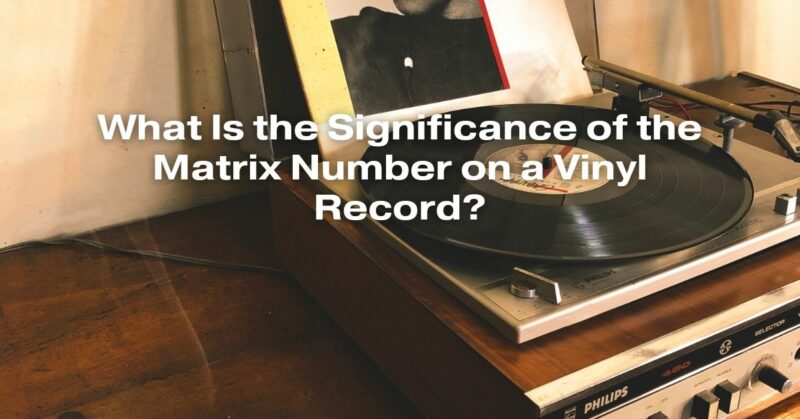In the realm of vinyl records, there’s an entire universe of information etched into the grooves beyond just the music itself. One of the intriguing enigmas lies in the form of a seemingly random code – the matrix number. This cryptic inscription, usually found on the run-out groove of a vinyl record, holds a wealth of information about the record’s production process and history. Understanding the significance of the matrix number provides enthusiasts with a unique glimpse into the fascinating world of vinyl record manufacturing.
Decoding the Matrix Number
A matrix number is a combination of letters and numbers that is stamped or etched into the run-out groove area of a vinyl record. This alphanumeric code serves as a unique identifier for a specific version of a record. It typically includes details such as the catalog number, the side of the record (A or B), and a code representing the pressing plant and the stamper used for that particular copy.
Catalog Number: The Record’s Identity
The catalog number embedded within the matrix number is crucial for identifying the record. It refers to a unique alphanumeric code assigned by the record label to a specific release. Collectors often use this number to categorize and differentiate between different editions of the same album, including special editions, reissues, and limited pressings.
Pressing Plant and Stamper Codes: Tracing the Record’s Origin
The matrix number also contains information about the pressing plant where the record was manufactured and the stamper used in the production process. Different plants have distinct codes, allowing collectors to trace the geographical origin of a particular vinyl. Moreover, the stamper code indicates the specific metal plate used to press the record. Stamper changes occurred after a certain number of pressings, affecting the sound quality and overall fidelity of the vinyl. Audiophiles often pay attention to these details, as records pressed from early stampers are generally considered to have superior audio quality.
Historical Significance: Uncovering Vinyl Record History
Beyond its technical details, the matrix number also holds historical significance. By deciphering these codes, collectors and enthusiasts can unveil the chronology of a record’s production. They can discern which pressings are original releases and which ones are reissues or later editions. This historical context enhances the value of a vinyl record, especially for collectors who seek authenticity and rarity.
Collectors’ Paradise: The Allure of Matrix Numbers
For vinyl enthusiasts and collectors, deciphering matrix numbers becomes a thrilling pursuit. It’s a way to unravel the intricate tapestry of a record’s journey from the pressing plant to their collection. The presence of unique matrix numbers adds an element of mystique and excitement to the world of vinyl collecting. Discerning collectors often share their findings online, contributing to a communal knowledge base and enriching the vinyl collecting experience for others.
Conclusion
The matrix number on a vinyl record might seem like a random assortment of letters and numbers, but it carries a profound significance for collectors and enthusiasts. It serves as a gateway to understanding the record’s identity, origin, and historical context. Decoding these matrix numbers enriches the vinyl collecting experience, transforming it from a mere hobby into a captivating journey through the annals of music production. As long as vinyl records continue to captivate hearts, the matrix number will remain a cherished enigma, connecting collectors with the rich history of their favorite albums.


